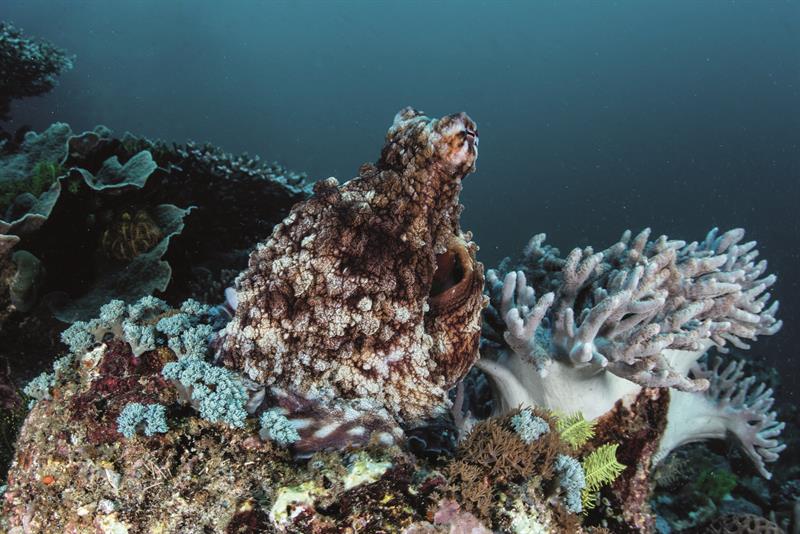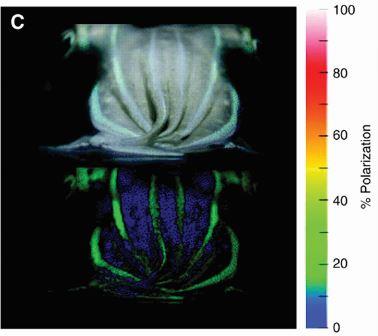
Of all the families of animals, the cephalopods are probably the strangest. Members of the family, which include cuttlefish, squid and octopus, are famous for being masters of disguise, changing their body colour and even the texture of their skin to camouflage themselves. As figure 1 shows, it can sometimes be hard to tell where a coral outcrop ends and an octopus begins. (For an even more spectacular example, check out www.youtube.com/watch?v=JSq8nghQZqA).
 Figure 1: An octopus demonstrating its amazing ability to camouflage itself against the background using both colour and skin texture.
Figure 1: An octopus demonstrating its amazing ability to camouflage itself against the background using both colour and skin texture.
Perhaps the only thing more astonishing than their amazing colour-changing abilities is that cephalopods manage to perform their amazing feats of camouflage without being able to see colour.
While we refer to some humans and animals such as dogs and cats as being colour-blind as they cannot see red, only green and blue, cephalopods are truly colour-blind (with one exception). They can only see in shades of green, which is effectively like seeing in black and white. We know this from two strands of research; anatomy and behaviour. Anatomically, octopus, squid and cuttlefish only have a single visual pigment in their eyes, which means they can only see the wavelength range (colour) that particular pigment is sensitive to. The exception to this is the firefly squid, which has three visual pigments, potentially giving it trichromatic vision like ourselves.
However, having just one visual pigment does not necessarily make an animal colour-blind; some spiders have managed to create a colour vision system using only a single visual pigment using some anatomical tricks with their lens and retina. Are octopus, squid and cuttlefish also doing something clever with the anatomy of the eye to let them see a colourful world? Probably not; we have neither anatomical evidence for any such structure and nor behavioural evidence for them being able to see the world in anything other than shades of grey.
Colour test
There are many different ways of testing for colour vision behaviourally. One of the most common experiments involves a discrimination task. In these, animals are trained to associate a certain stimulus with a food reward. Once trained, the animal is then presented with a choice of stimuli; the one they are trained on and a novel stimulus. The theory (which has stood the test of time) is that the animals should choose the stimulus they were trained on (because it is associated with food) over the novel stimulus, but only if they can tell the difference.
To take one example, octopuses were trained to attack a grey rectangle in return for a food reward (1g of sardine to be precise). Once trained, they were given a choice between a grey rectangle and a yellow rectangle that had the same brightness. This is important; brightness is a property of light that is separate from colour. If there is a brightness difference between the yellow and the grey, then the octopus could still be able to tell the difference between the two even though it might not be able to tell that the yellow rectangle is actually a different colour. The octopuses were unable to distinguish the yellow from the grey rectangle, nor were they able to tell a violet from a grey rectangle with the same overall brightness. Similar experiments have been done with cuttlefish and squid, all of which show a similar outcome; an apparent inability to tell the difference between coloured and grey shapes. However, all of the cephalopods tested have shown acute sensitivity to differences in the brightness of stimuli. So how do they manage to change the colour of their skin to match their background so well if they cannot even see the colour?
The answer, as always, is evolution. It turns out that cephalopods have a limited repertoire of ‘skins’. Cuttlefish (figure 2), for instance have 40 chromatic components to their body that they can ‘mix-and-match’ depending on the background of the environment in which they find themselves. For instance, on a relatively featureless substrate like sand, cuttlefish will also make themselves featureless and sandy-looking (figure 3). On small pebbles or noisy granular backgrounds, they will become mottled. For larger backgrounds with larger stones of mixed colours, they tend to go for either high-contrast patterns or a mix of mottled with disruptive colouration to hide the outline of their body. Over millions of years of natural selection, the colours of these patterns have evolved to closely match the substrate that elicit them.
 Figure 3: Examples of the different strategies for camouflage employed by cuttlefish against different backgrounds. From A review of cuttlefish camouflage and object recognition and evidence for depth perception, E Kelman et al, The Journal of Experimental Biology, 211 2008.
Figure 3: Examples of the different strategies for camouflage employed by cuttlefish against different backgrounds. From A review of cuttlefish camouflage and object recognition and evidence for depth perception, E Kelman et al, The Journal of Experimental Biology, 211 2008.
Natural selection
Cuttlefish displaying patterns with poor colour or texture matches to the background are more obvious, and therefore more susceptible to predators, while the animals that do match are more likely to survive.
Through natural selection, the colour of the pattern cuttlefish use when on a sandy background matches the colour of the sand, just as the colour of the high contrast patterns used when in a habitat with large pebbles matches the natural colouration of rock. The cuttlefish are not having to make separate colouration choices along with the choice of pattern. A quick aside; when stating that the cuttlefish’s colours are a good match to the background, it is important to define the visual system of the relevant observer, which would be fish in the case of cuttlefish since they are their main predators. Visual modelling using hyperspectral cameras to mimic fish vision shows that the cuttlefish colouration repertoire does indeed work as effective background matching camouflage.
So when it comes to camouflage, all that a cuttlefish has to do is identify the pattern of the substrate in order to match it; the colours are already hard-wired. However, this means their camouflage abilities are limited to natural scenes. If you were to put a cuttlefish in a paddling pool decorated with something fanciful like lime-green dolphins, you would not end up with a dolphin-decorated cuttlefish. Instead, they would choose the skin pattern that would match the closest natural substrate to the dolphin pattern (no idea what that would look like!). So the amazing colour-changing camouflage abilities of cephalopods relies not on colour vision, but on contrast vision enabling them to see the pattern and texture of the background. The colour comes ‘free’ with the pattern. All of which is underpinned by millions of years of evolutionary experience.
But back to the question of colour vision; do cephalopods really see a dull, grey world, or is there an extra dimension to their vision? The short answer is yes. While humans largely depend on colour vision, cephalopods have evolved to use polarisation instead. Polarisation is one of the fundamental characteristics of light alongside colour and brightness, yet is often overlooked, probably because we don’t have polarisation vision. While colour describes the wavelength of light, polarisation is a geometric description of how light waves travel through space. There are several sources of polarisation in the natural environment. The sky has a polarisation pattern caused by sunlight scattering from small molecules in the atmosphere, which many insects use for navigation. Amazingly, this skylight polarisation pattern is visible from under (shallow) water, though it is not yet clear whether marine animals also use it for navigation. The ‘veiling light’, that is the light from open water up to depths of 50m is also partially polarised due to light scattering from particles in the water. Finally, there is polarised light that is produced by animals themselves.
As the false colour image in figure 4 shows, cuttlefish are capable of producing polarisation patterns across their bodies and over their tentacles. Recent studies have shown that these polarisation-reflection structures are under neural control; in other words cuttlefish can actively control the polarisation patterns of their skin. So we know that they can produce polarisation patterns at will, but can they see them?
 Figure 4: Cuttlefish can display polarisation patterns (false colour in lower panel) alongside colour and intensity patterns (top). Taken from ‘Do cephalopods communicate using polarised light reflections from their skin?’, L Mathger et al, The Journal of Experimental Biology, 212 2009.
Figure 4: Cuttlefish can display polarisation patterns (false colour in lower panel) alongside colour and intensity patterns (top). Taken from ‘Do cephalopods communicate using polarised light reflections from their skin?’, L Mathger et al, The Journal of Experimental Biology, 212 2009.
Polarisation over colour
So why have cephalopods, by and large, chosen polarisation vision over colour vision, and why not have both? While we cannot be certain of the answer, it seems likely that it is due to the unreliability of colour underwater. In very shallow water, things look much as they would in air. However, as you start going deeper, the red portion of the spectrum is increasingly absorbed by the water. Recall from your (perhaps distant) memory of physics that objects appear to be a specific colour due to the wavelengths of light that they reflect. So a red object appears red (to an animal who can perceive red, of course) because it absorbs all wavelengths of light other than red. In deep water, if there is no red light, then red-reflecting objects appear black. Incidentally, this is why so many deep sea animals are red – it is actually quite a good form of camouflage. In summary, the colour of an object underwater will depend on the depth, making colour an unreliable source of information. Polarisation, on the other hand, does not change with depth, which is especially important when it comes to communication.
Imagine a communication system used by an animal that lives at multiple depths; a red signal in the shallows becomes a black signal in the deep, which could mean something completely different, or not be seen at all. Cuttlefish have an elaborate means of communication that uses both intensity and polarisation. The reliability of that communication channel could be the difference between a friendly or an unfriendly interaction; it could well be the difference between life and death.
So in summary, the brilliant colour-changing abilities of cephalopods are all the more amazing given that the animals cannot even see colour. Rather than a visual system relying on colour and intensity, as we do, cephalopods use polarisation and intensity channels instead.
Their camouflaging abilities come from being able to correctly identify the type of background and changing their body pattern accordingly, evolution having already taken care of the colour-matching side of things.
Dr Ilse Daly is a research associate at the School of Biological Sciences at the University of Bristol.
